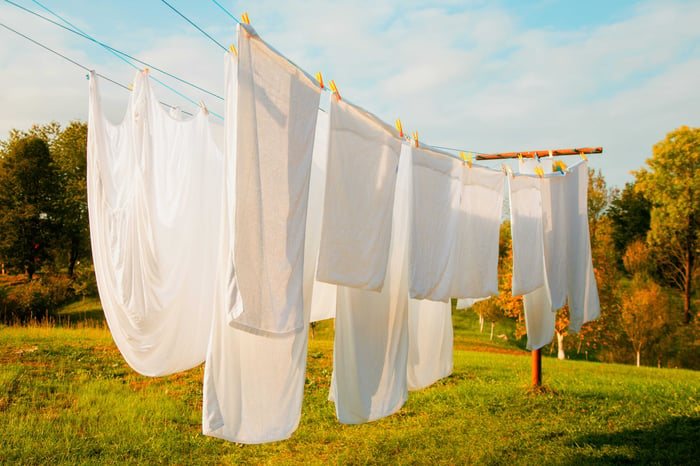Table of Contents
- The Hidden Dangers of Synthetic Bedding: What’s Lurking in Your Comforter?
- What is a down alternative comforter?
- The Toxic Truth About Synthetic Bedding
- Microplastics: The Unseen Invaders
- Off-Gassing and Indoor Air Quality
- The Environmental Toll of Synthetic Bedding
- The Hidden Costs of “Hypoallergenic” Marketing
- The Impact on Sleep Quality
- Allergies and Sensitivities
- The Short Lifespan of Synthetic Bedding
- Ethical Considerations of Synthetic Bedding Production
- Wool as a Natural Fire-Resistant Alternative
- The Safer, Sustainable Alternative: Regenerative Wool
- Sleep Without The Chemicals
- FAQs on Wool Duvet Inserts, Comforters & Sustainable Bedding
The Hidden Dangers of Synthetic Bedding: What’s Lurking in Your Comforter?
When you slip into bed at night, the last thing you expect is to be surrounded by harmful chemicals and microplastics. But if you’re sleeping under a poor-quality down alternative comforter, that might be exactly what’s happening. While down alternative comforters and polyester-filled bedding are marketed as affordable and hypoallergenic, they have hidden dangers that can disrupt your sleep, harm your health, and negatively impact the environment.
Most people don’t think twice about what’s inside their comforter — but they should. Many down alternative comforters are made from synthetic fibers that trap heat, shed microplastics, and off-gas harmful chemicals into your home. Here’s what’s really inside your bedding, and how switching to organic, regenerative wool can change your sleep and your health.
What is a down alternative comforter?
A down alternative comforter is bedding designed to mimic the warmth and softness of traditional down without using animal feathers. Instead, it is filled with synthetic fibers like microfiber, polyester, or other hypoallergenic materials, making it an excellent option for those with allergies or ethical concerns about animal products. These comforters are often lighter, easier to maintain, and more affordable than real down, providing cozy insulation for a comfortable sleep.
A down alternative comforter is a type of bedding filled with synthetic fibers — usually polyester — designed to mimic the feel of down. While marketed as allergy-friendly, these synthetic materials often come with hidden drawbacks for your health, home, and the environment.However, the microfiber used in down alternative comforters is made from ultra-fine synthetic fibers. This material is designed to trap heat, offering warmth without excessive weight.
 Synthetic materials break down into microplastics that pollute our environment—and often end up in our homes through bedding made from petrochemical fibers | Antipodean Home
Synthetic materials break down into microplastics that pollute our environment—and often end up in our homes through bedding made from petrochemical fibers | Antipodean HomeThe Toxic Truth About Synthetic Bedding
Down alternative bedding can be toxic if it contains chemicals like formaldehyde, flame retardants, and VOCs. However, some down alternative comforters are made from organic, non-toxic materials. Researching and choosing options free from harmful substances is essential to ensure a healthier sleep environment. The main problem with down alternative comforters is that they trap heat and bacteria, creating an environment that can lead to night sweats and allergen buildup, further disrupting sleep quality.
⚠️ Synthetic comforters can release up to 10,000 microplastic fibers per wash cycle and off-gas VOCs linked to poor indoor air quality.Most down alternative comforters are made from petroleum-based materials like polyester, which undergo extensive chemical processing. These materials often contain:
- Volatile Organic Compounds (VOCs): These chemicals off-gas from synthetic fibers and contribute to indoor air pollution. Prolonged exposure to VOCs can lead to headaches, dizziness, and respiratory issues.
- Flame Retardants: While intended to reduce fire hazards, many flame-retardant chemicals are linked to hormone disruption and developmental problems.
- Formaldehyde: Used to prevent wrinkling and improve durability, formaldehyde is a known irritant that can trigger allergies and asthma.
- Dyes and Finishes: Many down alternative products use toxic dyes and chemical finishes that can irritate the skin and cause allergic reactions.
Microplastics: The Unseen Invaders
Tiny plastic particles are shed into the air and your home environment when you fluff, wash, or sleep under a down alternative comforter.
These microplastics contribute to indoor pollution and can be inhaled or absorbed through the skin. Recent studies suggest that microplastics can accumulate in the lungs, bloodstream, and organs, raising concerns about long-term health effects.
 Natural, breathable bedding supports healthier indoor air and deeper rest—without the chemicals found in synthetic materials.
Natural, breathable bedding supports healthier indoor air and deeper rest—without the chemicals found in synthetic materials.Off-Gassing and Indoor Air Quality
That "new bedding" smell? It’s likely from off-gassing—releasing chemical fumes from synthetic materials. These gases can linger for weeks or even months, creating an invisible but persistent pollutant in your bedroom. Off-gassing can cause:
- Eye, nose, and throat irritation
- Worsening of asthma and allergies
- Long-term effects on hormone balance and immune function
The Environmental Toll of Synthetic Bedding
Beyond personal health risks, down alternatives are a major contributor to plastic pollution. Since polyester and other synthetic fibers are non-biodegradable, discarded bedding piles up in landfills and releases microplastics into waterways. Additionally, the production of these materials relies on fossil fuels, further driving carbon emissions and climate change.
The Hidden Costs of “Hypoallergenic” Marketing
Many down alternative comforters claim to be “hypoallergenic,” but that usually just means they don’t use animal products. It doesn’t mean they’re chemical-free or safe for sensitive skin. True hypoallergenic comforters are made from natural fibers like organic wool or cotton, which resist dust mites and mold without synthetic coatings.
The Impact on Sleep Quality
Synthetic bedding materials trap heat and moisture, leading to overheating and discomfort during the night. This disrupted thermoregulation can cause night sweats, frequent awakenings, and poor sleep quality. By contrast, natural fibers like wool regulate temperature more effectively, ensuring a cooler, more restful night’s sleep.
Allergies and Sensitivities
Many people switch to low-quality down alternative comforters, believing they are hypoallergenic, but synthetic materials can still harbor dust mites, mold, and bacteria. The chemical treatments used in these fibers can also trigger skin irritation and respiratory issues and worsen conditions like eczema or asthma. Choosing natural, untreated materials significantly reduces these risks.
The Short Lifespan of Synthetic Bedding
One of the main reasons people opt for a down alternative comforter is their affordability. Down alternative comforters are often significantly cheaper upfront than high-quality natural options. However, the trade-off for this lower cost is a shorter lifespan and lower performance. These synthetic materials lose their loft and comfort quickly, meaning they must be replaced more often, leading to higher long-term costs and more waste in landfills.
Unlike natural fibers that soften and improve with age, down alternative comforters tend to degrade quickly, losing loft and support over time. Washing these materials frequently can cause them to break down faster, releasing more microplastics into the environment. Investing in high-quality, natural bedding ensures long-term durability and comfort.
Ethical Considerations of Synthetic Bedding Production
Beyond health and environmental concerns, producing down alternative comforters raises ethical questions. Many synthetic fibers are produced in factories with poor labor conditions, contributing to worker health issues and unfair wages. Choosing ethically sourced, natural bedding supports fair labor practices and more responsible manufacturing.
Wool as a Natural Fire-Resistant Alternative
Nature had it right from the start. Unlike synthetic materials that require chemical treatments to compensate for their shortcomings, natural fibers like wool have built-in benefits that make them superior for bedding. Wool has evolved to regulate temperature, wick away moisture, and resist dust mites and mold without synthetic additives.
By choosing natural materials, we align ourselves with what has worked for centuries rather than relying on industrial shortcuts that come with harmful side effects.Unlike down alternatives that require chemical flame retardants, wool is naturally fire-resistant due to its unique fiber structure. This eliminates the need for harmful chemical treatments, making it a safer choice for both personal health and home safety.
The Safer, Sustainable Alternative: Regenerative Wool
Natural materials like regenerative wool offer a superior alternative if you want to sleep in a healthier, toxin-free environment. Unlike synthetics, wool is:
Breathable and moisture-wicking, preventing overheating and night sweats
Naturally hypoallergenic, resisting dust mites and mold
Free of harmful chemicals, ensuring clean, fresh air in your bedroom
Sustainable and biodegradable, reducing environmental impact
At Antipodean Home, we craft our comforters from regenerative wool from New Zealand farms. Our Airlay design makes our bedding lighter, more breathable, and better for deep, restorative sleep than bulky, synthetic alternatives.
Sleep Without The Chemicals
Your bed should be a sanctuary, not a source of hidden toxins. Choosing regenerative, all-natural bedding can create a healthier home, improve your sleep quality, and support a more sustainable future. Ready to make the switch? Explore our collection of organic wool comforters and experience the difference of natural sleep.
FAQs on Wool Duvet Inserts, Comforters & Sustainable Bedding
Are down alternative comforters toxic?
Most down alternative comforters are made with polyester or microfiber — both petroleum-based materials that can off-gas and release microplastics. If you’re looking for a non-toxic comforter, choose one made from organic wool or cotton.
What is the safest comforter material?
The safest comforters are made from natural fibers like organic wool and cotton. They’re breathable, chemical-free, and biodegradable — healthier for both you and the planet.
Are down alternative comforters good for allergies?
They can help some people, but synthetic fills still trap dust and moisture. Organic wool comforters naturally repel allergens and wick away humidity, keeping your sleep cleaner and cooler.
What’s better: wool or down alternative?
Wool comforters outperform synthetics in breathability, moisture control, and longevity. They also regulate temperature naturally, helping you stay comfortable through every season.
Are synthetic comforters bad for the environment?
Yes — they’re made from nonrenewable materials that shed microplastics and can take centuries to decompose. Choosing regenerative wool bedding supports cleaner air, soil, and oceans.




